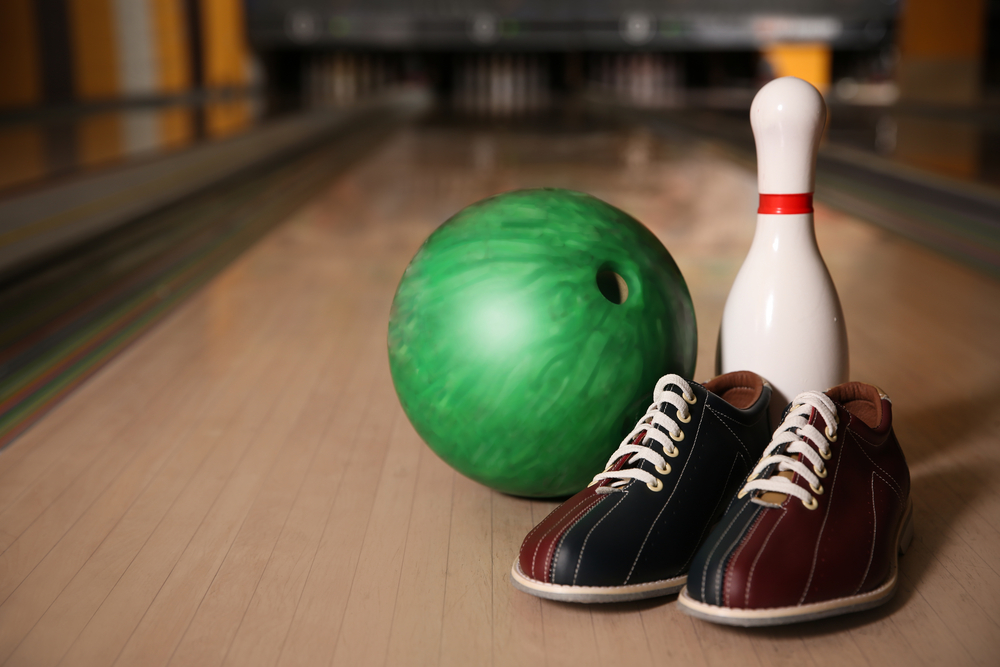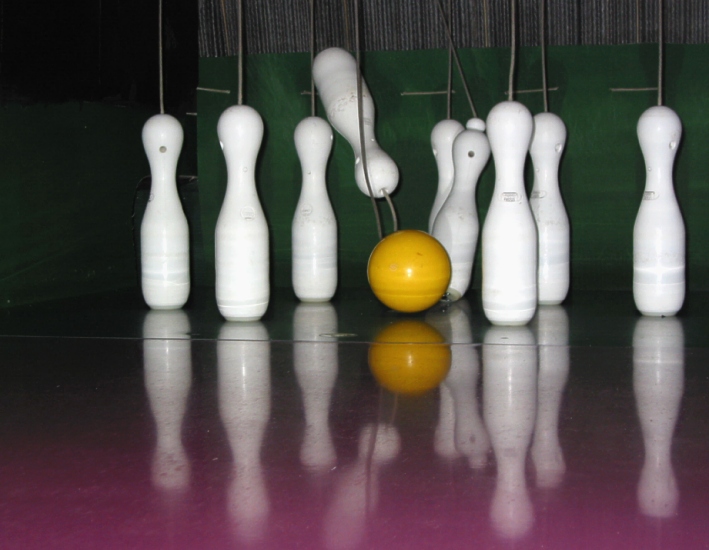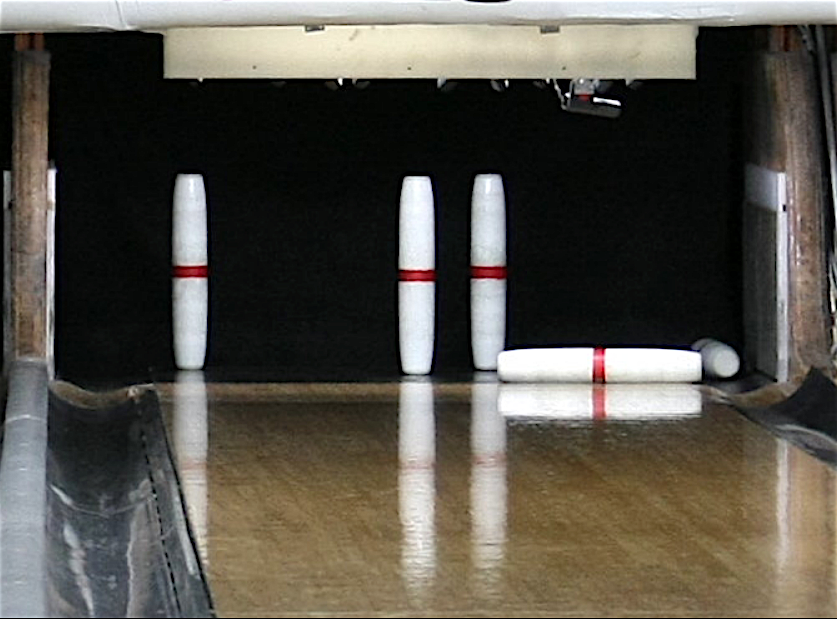
Even if you’ve never bowled, you likely have a basic understanding of how the game works. You roll the ball and knock down as many pins as you can. Your score is based on how many pins you knocked down.
But after jumping into the sport, you'll soon realize that there's more to the game than you initially thought. In this article, we'll fill you in on the rules of bowling so you can hit the lanes with confidence.
Contents
Bowling Rules
Ten Pin Bowling Rules: The Basics
Ten-pin is the U.S.'s most common form of bowling. So, if you live in the U.S., this is the type of bowling you’ll play in most cases. The basic rules of play include the following:
- The ultimate goal is to knock down all ten pins on your first turn.
- During each frame, each player gets two attempts to knock down all ten pins. Turns are called “frames,” and each player plays ten frames in a game.
- Knocking down all the pins on your first throw is called a strike.
- If you miss at least one pin on the first throw and then knock down any remaining pins on your second throw, it's called a spare.
- If a player bowls a strike in the tenth frame, they get two more throws within that frame. If they get a spare in the final frame, the player gets to throw one more ball.
- Open frames are simply frames that left at least one pin standing. The Rules of Ten Pin (10 Pin) Bowling - EXPLAINED!
- Scoring is based on the number of pins knocked down. Except, when you get a spare, you get 10 plus the number of pins you knock down during your next throw. If you get a strike, you get 10 plus the number of pins you knock down with your next two throws.
- Game totals are typically an average of three games played. To determine this, you take the three-game scores, add them together, and divide that number by three.
- Honor the foul line. If a player steps over the foul line or crosses it in any way, those pins will not count toward that player's score.
- Unless otherwise authorized, bumpers should not be used during a game.
- For players with physical disabilities, ramp bowing may be allowed.
USBC Ten-Pin Bowling Rules: Technical
The United States Bowling Congress, or USBC, originated in 2005 as the national governing body of bowling. They’re also recognized by the US Olympic Committee. This organization maintains and provides the rules and regulations of bowling.
While the USBC is much more than just a rule maker, it is considered the ultimate resource for the sport. As of 2022, the USBC rescinded any rule changes that had been made in response to the COVID-19 pandemic. This included no longer letting players use isopropyl alcohol to clean their balls once a competition has begun.
Lane spacing requirements are also no longer in place. In addition to keeping the world of bowling up to date based on worldly events and needs, the USBC sets general playing rules. These rules apply mainly in tournaments, but most of them are enforced at your local bowling alley.
Here they are:
- Delivering the Ball: The ball has been “delivered” when it leaves the bowler's hand and passes the foul line onto the lane. All deliveries must be made by the bowler with no artificial or mechanical assistance. (Some amendments allow for exceptions based on amputation or other similar situations.)
- Fouls: You have committed a foul when any part of your body touches or crosses the foul line. If you commit a foul, your turn will count, but you will not get credit for fallen pins.
- Legal Pinfall: When scoring a game, any points that count for the bowler will include:
- Pins that fall from the impact of the ball or another pin that is hit by a falling pin.
- A pin that is knocked down by a rebounding pin that ricocheted off of another surface.
- Pins that are moved off the lane or downed by a pin that rebounds from the sweep bar.
- If a pin is propped up by any part of the structure surrounding the fallen pins.
- Illegal Pinfall: Illegal pinfall dictates that your throw will count, but you will not get points. Here are some instances of illegal pinfall:
- If you throw a ball and it jumps the lane or enters the gutter before reaching the pins.
- When a pin touches any part of the pin setter.
- Anytime a foul is committed by the player.
- When your ball hits a human pinsetter. Most bowling alleys have mechanical pinsetters, so you probably won't have this issue.
- When a pin falls during pin removal.
- When a ball deflects off of the rear cushion, any resulting pins being knocked down will not count.
- When a pin falls because of a human pinsetter.
- If the bowler throws while there is still dead wood anywhere on or around the lane. Players are responsible for determining whether there are any remaining pins on the lane before they throw.
- The ball comes into contact with dead wood before it leaves the lane.
- Your throw is made while dead wood is present or in the gutter, and more pins fall down due to subsequent contact.
- Pins: Each player is responsible for ensuring the pin setup is correct. They should insist that it be corrected before their turn. If it's discovered that any pins were set improperly but is all there, the delivery and pinfall will count.
- Dead Ball: If a dead ball is called, the delivery won’t count, and any downed pins must be reset. A dead ball can be called if it is noticed that one or more of the pins were missing after a delivery was made, if a human pinsetter interferes or removes any pins before or during a roll, or if a player bowls down the wrong lane or out of turn, and more.
These are just the basic rules to give you an idea of how bowling is both played and regulated, especially during official games and tournaments. Here is the USBC website for a complete list of all their rules.

Different Bowling Rules for Bowling Variations
Now that you understand some of the most important bowling rules, it's essential to learn how each type of bowling game is played. There are five main types of bowling, including ten-pin bowling. Here are the other variations to know about: nine-pin bowling, five-pin bowling, Duckpin bowling, and Candlepin bowling.
Nine-Pin Bowling
For nine-pin bowling, the pins are lined up in a diamond shape. The center pin is known as the “9” pin and is typically red in color. The pins are further apart than they are in ten-pin bowling, and the nine pin is a tad longer than the other pins.
Nine-pin bowlers play in teams of 6. Players are not stuck in a fixed rotation. The team captain or leader can select which bowler will start and who will follow.
Teams bowl the first three frames on one lane and then switch with the other team for the remaining three. Each bowler is given two balls to roll. If a “ringer” (also known as a strike in 10-pin bowling) is scored by knocking down all of the pins, the score will be 9.
However, if all the pins are knocked down and the 9-pin is still left standing, the score will be calculated as 12. This allows players to score a max of 24 points per frame. If a player does not throw a ringer on the first ball, he can use the second ball to try to get a spare.
When a player cannot score, the captain can call in another player to try on the next throw. No score is awarded to a team until they knock all of the pins down or only the red pin remains standing. The exception to this rule is when the last team member rolls their last ball - in this case, each fallen pin will count as a point.
All frames are added together to calculate the team’s score. This is simply called a team score. No individual player scores are counted in this type of game, leading to a collaborative event that relies more heavily on teamwork than some other bowling games.

Five-Pin Bowling
Five-pin bowling is a variation of bowling that’s most popular in Canada. As the name of the game suggests, it uses 5 pins instead of 10. Five-pin bowling teams get three chances to bowl per frame and have their own unique point system.
Each game has ten frames, just like 10-pin bowling. The game has three shots per frame. An open frame refers to when all three bowler’s shots couldn’t knock down all of the pins.
Just like 10-pin bowling, in 5-pin bowling, a strike involves knocking down all of the pins with one throw, and a spare involves clearing all the pins after 2 throws. The pins are arranged in a V-shape, and each one has its own value. For example, if you hit the headpin at the top of the “V,” you will earn 5 points.
The two pins on either side of the center pin are worth three points each. The last two pins are worth two points each. The total points a player can earn in a game will depend on the pins you knock down and whether you get a spare or strikes in your frames.
If you can get a strike on your first frame, you will earn the most points for that shot which is 15. If you can score a strike on the next two shots, you can earn up to 45 points for that frame. For the times you don’t get a strike but can get a spare, you’ll get the 15 points from the spare as well as any extra pins you knocked down with your next throw.
In addition, any other frames without a strike or a spare will be awarded the points associated with the downed pins. One of the main differences between five-pin bowling and ten-pin bowling is the size of the ball. Five-pin bowling uses a ball that’s nearly the size of a softball to ensure that the game is accessible to people of all ages and sizes.

Duckpin Bowling
Duckpin bowling is considered to be another variation of 10-pin bowling despite some significant differences. Just like in five-pin bowling, the Duckpin ball is about the size of a softball and does not have any finger or balance holes. The pins are shorter and lighter than their 10-pin counterparts, yet they are arranged in the same triangular formation.
The rules of Duckpin bowling allow for a 10-frame game with three rolls per frame. The goal is to knock down as many pins as possible during each frame. If a player can knock down all the pins with their first throw, it’s considered a strike.
They get the points for that roll (one point per pin) plus the number of pins they knock down with the next two balls. When a player can knock down ten pins within two throws, that’s called a spare. The player gets the full ten points in addition to the number of pins they can knock down on the next throw.
If all the pins are taken down on the third throw, the player gets 20 points for their turn. The final score comprises all the points accumulated over ten frames. The maximum score a person can get is 300 points, which is only achievable if a player can get 12 consecutive strikes.
At this time, there’s no evidence that anyone has been able to accomplish this feat.

Candlepin Bowling
In this bowling game, every player rolls a small ball to knock down ten pins set up in the same formation as in a 10-pin bowling game. Every player is allowed three rolls, each turn in ten frames. Any pins that are knocked down will remain in place until the end.
If a player can knock all ten pins down using their first roll, they get the full 10 points for a strike and continue to play for the next two rolls. This is after the pins are cleared and set up again for a new roll. There is the potential to score three strikes within a single frame.
If it takes three rolls to knock down all the pins, the total of that frame will be 10. This is often referred to as a ten-box in the New England area. Scoring is similar to that of Duckpin bowling and is considered to be official.
All scores must be correctly reported and submitted frame by frame. You can get fouls while playing this game. A foul occurs when a ball first rolls into the gutter before it hits dead wood or jumps back out of the gutter, hitting extra pins.
You can also get a foul if your ball is “lobbed” and doesn’t touch the approach or within three meters of the lob line. There are alley-specific rules about the rotation of play, such as if more than one person is bowling on the same lane at the same time. So if you’re getting involved in a Candlepin bowling game, make sure to ask about how that will work during your games.

Bowling Alley Rules
No matter which bowling variation you play, you have some rules to learn. It’s okay if you don’t memorize every single rule before you show up to play a game. Bowlers tend to be friendly yet competitive people.
Most bowlers will take the time to help you become acclimated to the sport. And now that you know about the different kinds of bowling games and rules, there’s another significant set of rules. Your game will be subject to the bowling alley rules whenever you bowl.
Many times an alley will post rules for all visitors to read and observe. Some of these regulations may address safety, while other rules require good etiquette while playing. No matter the alley’s rules, it would be best if you took the time to understand them.
Bowling alley rules may differ from location to location, but they all serve an essential purpose.
Here are some rules that come up a lot in bowling:
- When another player is bowling, remain seated.
- Don’t make loud, sudden noises to break another bowler’s concentration.
- Where bowling shoes when on the lane approach.
- Don’t bring food and drinks into the bowling area.
- Wear a shirt and pants.
*This is not an exhaustive list of rules.
Conclusion
Related Articles
When a person first sees the number of games and rules required to enjoy bowling, it can be off-putting. The good news is that many rules are the same across several bowling variations. Once you learn some basic rules, you’ll have a good foundation for whichever variation you play.
The rules also evoke a sense of awe regarding how involved and precise the sport is and the passion people have for it. So learn the rules as best as possible and ask for help or clarification if needed.
We hope you found the information you were looking for. Good luck!
Kira Byrd, a Certified Fraud Examiner, holds a B.S. in Accounting from the University of Alabama at Birmingham. With a passion for bowling from her childhood, Kira has poured her expertise and personal experiences into creating and nurturing Bowling For Beginners. Kira's mission is to meet new bowlers where they are and guide them toward consistently achieving higher scores. With a focus on skill development and strategic techniques, she empowers readers to take control of their game and unlock their true potential.
Bowling For Beginners embodies strict editorial integrity, ensuring reliable and unbiased information. Kira's commitment to delivering valuable insights and practical strategies is reflected in every article. Here's an explanation of our editorial policy and how we get money.





